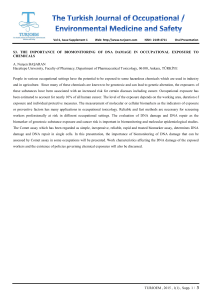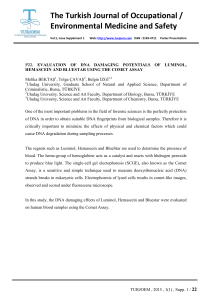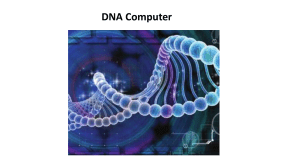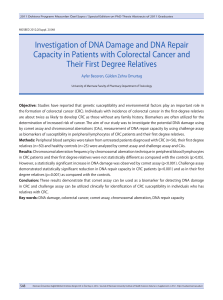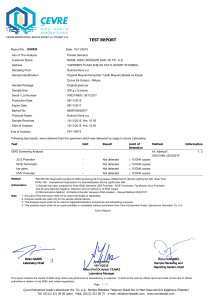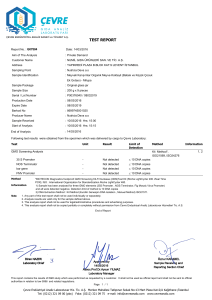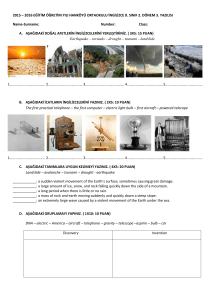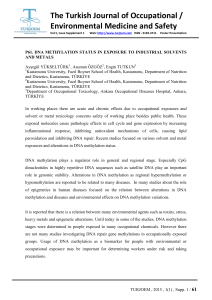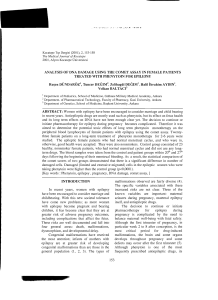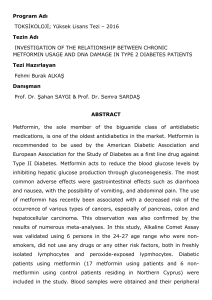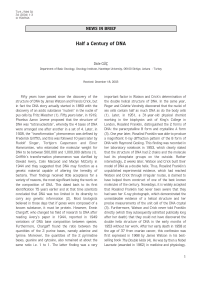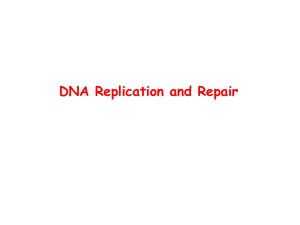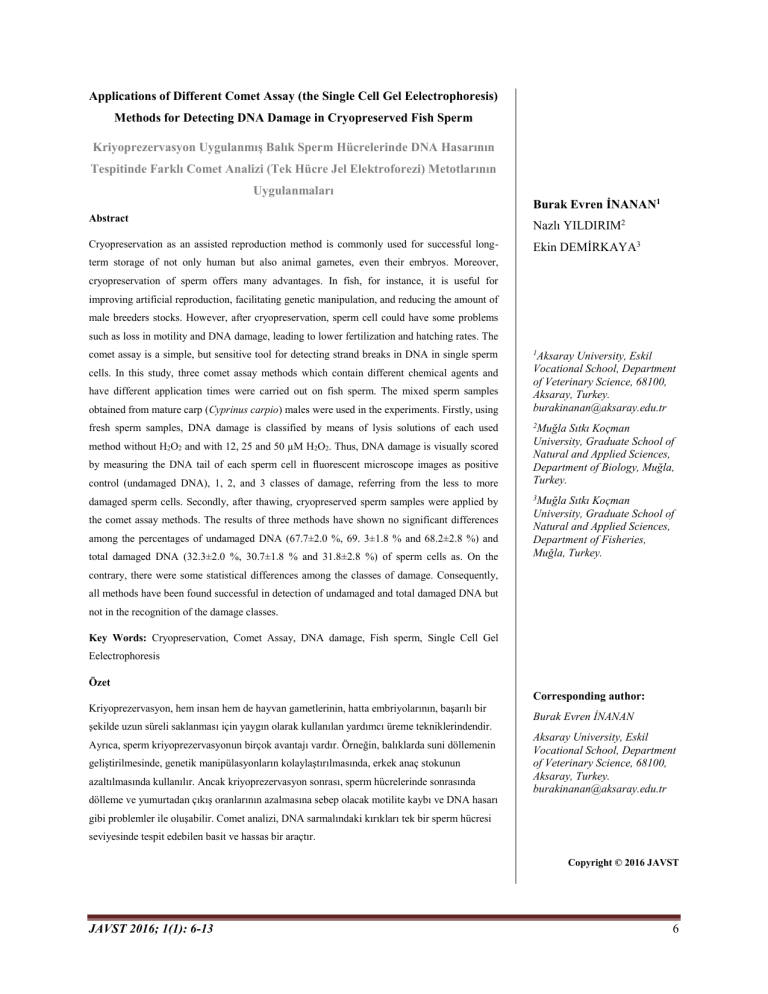
Applications of Different Comet Assay (the Single Cell Gel Eelectrophoresis)
Methods for Detecting DNA Damage in Cryopreserved Fish Sperm
Kriyoprezervasyon Uygulanmış Balık Sperm Hücrelerinde DNA Hasarının
Tespitinde Farklı Comet Analizi (Tek Hücre Jel Elektroforezi) Metotlarının
Uygulanmaları
Burak Evren İNANAN1
Abstract
Nazlı YILDIRIM2
Cryopreservation as an assisted reproduction method is commonly used for successful long-
Ekin DEMİRKAYA3
term storage of not only human but also animal gametes, even their embryos. Moreover,
cryopreservation of sperm offers many advantages. In fish, for instance, it is useful for
improving artificial reproduction, facilitating genetic manipulation, and reducing the amount of
male breeders stocks. However, after cryopreservation, sperm cell could have some problems
such as loss in motility and DNA damage, leading to lower fertilization and hatching rates. The
comet assay is a simple, but sensitive tool for detecting strand breaks in DNA in single sperm
1Aksaray
obtained from mature carp (Cyprinus carpio) males were used in the experiments. Firstly, using
University, Eskil
Vocational School, Department
of Veterinary Science, 68100,
Aksaray, Turkey.
[email protected]
fresh sperm samples, DNA damage is classified by means of lysis solutions of each used
2Muğla
cells. In this study, three comet assay methods which contain different chemical agents and
have different application times were carried out on fish sperm. The mixed sperm samples
control (undamaged DNA), 1, 2, and 3 classes of damage, referring from the less to more
Sıtkı Koçman
University, Graduate School of
Natural and Applied Sciences,
Department of Biology, Muğla,
Turkey.
damaged sperm cells. Secondly, after thawing, cryopreserved sperm samples were applied by
3Muğla
method without H2O2 and with 12, 25 and 50 µM H2O2. Thus, DNA damage is visually scored
by measuring the DNA tail of each sperm cell in fluorescent microscope images as positive
the comet assay methods. The results of three methods have shown no significant differences
among the percentages of undamaged DNA (67.7±2.0 %, 69. 3±1.8 % and 68.2±2.8 %) and
total damaged DNA (32.3±2.0 %, 30.7±1.8 % and 31.8±2.8 %) of sperm cells as. On the
Sıtkı Koçman
University, Graduate School of
Natural and Applied Sciences,
Department of Fisheries,
Muğla, Turkey.
contrary, there were some statistical differences among the classes of damage. Consequently,
all methods have been found successful in detection of undamaged and total damaged DNA but
not in the recognition of the damage classes.
Key Words: Cryopreservation, Comet Assay, DNA damage, Fish sperm, Single Cell Gel
Eelectrophoresis
Özet
Kriyoprezervasyon, hem insan hem de hayvan gametlerinin, hatta embriyolarının, başarılı bir
şekilde uzun süreli saklanması için yaygın olarak kullanılan yardımcı üreme tekniklerindendir.
Ayrıca, sperm kriyoprezervasyonun birçok avantajı vardır. Örneğin, balıklarda suni döllemenin
geliştirilmesinde, genetik manipülasyonların kolaylaştırılmasında, erkek anaç stokunun
azaltılmasında kullanılır. Ancak kriyoprezervasyon sonrası, sperm hücrelerinde sonrasında
dölleme ve yumurtadan çıkış oranlarının azalmasına sebep olacak motilite kaybı ve DNA hasarı
Corresponding author:
Burak Evren İNANAN
Aksaray University, Eskil
Vocational School, Department
of Veterinary Science, 68100,
Aksaray, Turkey.
[email protected]
gibi problemler ile oluşabilir. Comet analizi, DNA sarmalındaki kırıkları tek bir sperm hücresi
seviyesinde tespit edebilen basit ve hassas bir araçtır.
Copyright © 2016 JAVST
JAVST 2016; 1(1): 6-13
6
İnanan et al.
Applications of Different Comet Assay
Bu çalışmada, farklı kimyasal maddeler ve uygulama zamanlarına sahip üç farklı Comet analiz metodu balık sperm hücrelerine
uygulanmıştır. Olgun sazan balığı (Cyprinus carpio) bireylerinden alınan sperm örnekleri bu çalışmada kullanılmıştır. Öncelikle, taze
sperm örnekleri kullanılarak, her metot için liziz solüsyonuna 12, 25 ve 50 µM H2O2 eklenerek DNA hasarı sınıflandırılmıştır. Böylece,
DNA hasarı, her hücre DNA’sının oluşturduğu kuyruk uzunluğuna göre floresan mikroskop altında incelenerek görsel olarak, 1. 2. ve 3.
dereceden hasarlı ve H2O2 eklenmemiş örnekler 0 (hasarsız) olarak ölçeklendirilebilir. Sonrasında, kriyoprezervasyon uygulanmış sperm
örnekleri çözündürülerek, üç farklı Comet analiz metodu uygulanmıştır. Üç metoda ait yüzde hasarsız DNA sonuçları (%67,7±2,0; %
69,3±1,8 ve %68,2±2,8) arasında ve toplam hasarlı DNA sonuçları (%32,3±2,0; % 30,7±1,8 ve %31,8±2,8) arasında istatistiki olarak
önemli derece fark saptanamamıştır. Buna karşın, DNA hasar sınıflandırmaları arasında bazı istatistiksel farklılıklar bulunmaktadır.
Sonuç olarak, her üç metot hasarsız ve toplam hasarlı DNA tespitinde benzer başarıyı göstermekte iken DNA hasar sınıflarının
tanımlanmasında farklılıklar olabilmektedir.
Anahtar kelimeler: Kriyoprezervasyon, COmet Analizi, DNA Hasarı, Balık Spermi, Tek Hücre Jel Elektroforezi
Introduction
Soliman et al., 2004; Fraser & Strzeżek, 2005). Similar
In reproductive biology, cryopreservation is a common
damages in DNA have been found in different fish
method to preserve sperm cells, and has been applied in
species such as rainbow trout (Oncorhynchus mykiss),
sperm of different animal groups as well as in fish
gilthead sea bream (Sparus aurata), loach (Misgurnus
sperm (Barbas & Mascarenhas, 2009; Diwan et al.,
fosilis), sea bass (Dicentrarchus labrax) (Zilli et al.,
2010). The cryopreservation of sperm offers many
2003; Kopeika et al., 2003; Cabrita et al., 2005;).
benefits. In fish, for instance, the cryopreservation
The comet assay, or also known as single-cell gel
could be used in conservation of endangered fish
electrophoresis, is one of the common methods for
species, acquiring desired genotype through cross-
assessing DNA damage at individual cell level (Ostling
breeding, easy transportation of genetic material,
& Johanson, 1984). There are several different types of
broodstock protection, optimal sperm utilization in
comet assays which mostly vary based on the pH lysis
hatchery production and laboratory experiments, easy
and electrophoresis solutions (Nossoni, 2008). The
transportation of genetic material among hatcheries,
procedure of comet assay demonstrated in Fig. 1 has
economically and effectively maintenance of breeders
seven main steps; isolation of cells, preparation of
in hatcheries, experimental material for advanced
slides,
studies (Chao et al., 1987; Chao& Liao, 2001).
electrophoresis, neutralization, fluorescent staining and
Conceptually, the procedure of cryopreservation could
microscopic evaluation.
lysis,
unwinding
of
DNA
strands,
be divided into two main processes; the freezing and
accordingly fertility rate, loss of plasma membrane, the
ALKALI UNWINDING
(pH>13)
STAINING &
MICROSCOPY
ELECTROPHORESIS
integrity mitochondria and DNA (Cabrita et al., 1998;
Suquet et al., 1998). Damages in DNA as a result of the
cryopreservation procedure were determined not just in
human sperm also in boar, ram, and equine sperm by
comet assay (Hughes et al., 1997; Baumber et al., 2003;
JAVST 2016; 1(1): 6-13
LYSIS
NEUTRALIZATION
+
sperm cells associated with loss of motility and
SLIDES
CELLS
-
the thawing. These processes have potential to damage
Figure 1. The basic flow diagram of the alkaline comet assay
procedure, indicating main steps associated with the assay
(modified from Tice et al. 2008).
Şekil 1. Comet analizi temel prosedürünün temel
basamaklarını belirten akış şeması (Tice vd. (2008)’den
değiştirilerek).
7
İnanan et al.
Applications of Different Comet Assay
In this study, three comet assay methods, Singh et al.
three comet assay methods, Singh et al. (1988), Cabrita
(1988), Cabrita et al. (2005), Shen & Ong, (2000),
et al. (2005), Shen & Ong, (2000), are applied to the
which contain different chemical agents and have
sample, which main differences are summarized in
different application times were carried out on fish
Table 1. In all methods, for comet visualization 40 µl
sperm. These three methods have been compared with
ethidium bromide at final concentration 0.5 µg/ml were
regards to their detection capacity in DNA damage
pipetted into the sample, and the slides were examined
scores.
with a system combining a fluorescence Zeiss Axio
Scope A1 (Germany) microscope with AxioCam ICc 5
Materials and Methods
In this study, the mixed sperm samples that obtained
from mature carp (Cyprinus carpio) males manual
abdominal stripping while avoiding any contamination
from water, blood, urine, or faeces were used in the
experiments. The experiments were carried out in two
steps. Firstly, using fresh sperm samples, DNA damage
is classified by means of lysis solutions of each used
method without H2O2 and with 12, 25 and 50 µM H2O2.
Thus, DNA damage is visually scored by measuring the
DNA tail of each sperm cell in fluorescent microscope
images as positive control (undamaged DNA), 1, 2, and
3 classes of damage, referring from the less to more
camera. 100 cells were scored per slide in triplicate.
In cryopreservation procedure, the semen samples were
mixed in a ratio of 1:9 (v/v) with an extender composed
of modified Kurokura solution (62 mM NaCl, 134 mM
KCl, 2 mM CaCl2, 1 mM MgCl2, and 2 mM NaHCO3,
pH 8.2),10% DMSO, and 10% egg yolk (Magyary et
al., 1996). After dilution, the samples were drawn into
0.25 ml straws (IMV, France) and sealed with polyvinyl
alcohol. The straws were placed on a rack 2.5 cm above
a liquid nitrogen surface for 10 min and then plunged
directly into the liquid nitrogen. At least seven straws
per a sperm sample were frozen. After a week of
storage in liquid nitrogen, the samples were thawed in a
damaged sperm cells. Secondly, after thawing, the
20°C water bath for 30 s (Öğretmen & İnanan, 2014).
comet assay methods were applied by the cryopreserved
The results are shown as the means ± the standard
sperm samples.
Fresh and frozen/thawed sperm were rinsed with
phosphate buffer saline (PBS) solution, and diluted
until a final concentration of 8–10 x106 sperm per ml.
Slides were prepared one day before the experiments
deviation (SD). Non-parametric Mann–Whitney U tests
followed by Kruskall–Wallis test were used, and
α<0.05 were taken to indicate a significant difference
between the treatments in terms of percentages of DNA
damages.
applying a thin layer of normal melting point agarose,
eliminating agarose in excess. The slides were stored at
room temperature and protected from dust and light.
Low melting point agarose was prepared next day for
the second layer. This agarose was mixed with 30 µl
sperm suspension in an Eppendorf tube. The agarose:
sperm suspension was added to the slides covering with
a coverslip. After that, the coverslip was removed and
slides were left to solidify at 4 °C for 10min. For each
Results and Discussion
The classification of DNA damaged cells were
representative in Fig. 1. To obtain this classification,
fresh
samples
were
treated
by
the
different
concentrations of H2O2 in lysis solution. Under the
fluorescence microscope, the sperm samples treated
with lysis solution with H2O2 free were observed
spherical in diameter between 24-30 µm. DNA of
sample, three slides were prepared and examined. Then,
JAVST 2016; 1(1): 6-13
8
İnanan et al.
Applications of Different Comet Assay
sperm samples exposed by lysis solution with the
between 40-50 µm) and grade 3 severe damaged DNA
different concentrations of H2O2 were tailed, and length
(length between >50 µm), respectively.
of
higher
The three different comet assay methods were applied
concentrations of H2O2. Thus, the sperm samples
with the different concentrations of H2O2 in lysis
exposed by 12 µM H2O2 were visualized as an olive tail
solution to reveal that there is any difference in their
in 30-40 µm, and scored as grade 1 mild damaged
scaling or classification of DNA damaged (Fig. 3).
DNA. Similarly, the sperm treatments with 25 and 50
There were no significant differences between the
µM H2O2 have image formations in the fluorescence
percentage of both DNA undamaged and damaged cell
microscope grade 2 moderate damaged DNA (length
among the three methods (P>0.05). Each H2O2
the
tail
DNA
increased
with
the
treatments were reflected a grade of DNA damaged.
Table 1. The main differences in the steps of among the comet assay methods used in this study (Si;Singh et al., 1998: Ca;Cabrita et al.,
2005: Sh;Shen & Ong, 2000).
Tablo1. Bu çalışmada kullanılan COmet analizi metotlarının basamakları arasındaki temel farklılıklar (Si;Singh vd., 1998: Ca;Cabrita
vd., 2005: Sh;Shen ve Ong, 2000).
The steps
Gel setting on slides
Si
Bottom layer; 0.5% NMA1
Top layer; Sample mixed with
0.5% LMA2
Ca
Bottom layer; 0.5% NMA
Top layer; Sample mixed
with 0.5% LMA
Lysis solution
2.5 M NaCl,
100 mM Na2-EDTA,
10 mM Tris,
1% N-Lauroylsarcosine
1% Triton X-100.
2.5 M NaCl,
100 mM Na2-EDTA,
10mM Tris,
1% N-Lauroylsarcosine
1% Triton X-100.
Sh
Bottom layer; 0.75% NMA
Middle layer; Sample
mixed with 0.75% LMA
Top layer; 0.75% LMA
2.5 M NaCl,
100 mM Na2-EDTA,
10 mM Tris,
1% N-Lauroylsarcosine,
1% Triton X-100.
pH 10, for 1 h at 4 °C
pH 10, for 1 h at 4 °C
pH 10, for 1 h at 4 °C
+ 10 mM dithiothreitol
for 30 min at 4 °C.
+ RNase treatment3
for 4 h
+ proteinase K4 treatment
for 15 h
1 mM N2-EDTA,
300 mM NaOH
+ 4 mM lithium
diiodosalicylate
for 90min
1 mM Na2–EDTA,
300 mM NaOH
pH >13
for 20 min at 4 °C
pH 12
for 20 min at 4 °C
pH 10
for 20 min at 4 °C
for 20 min at 25 V,4 °C.
for 10 min at 25 V, 300 mA,
4 °C.
for 1 h at 12 V, 100 mA,
4°C
0.4 M Tris,
pH 7.5
for 5 min at 4 °C.
0.4M Tris,
pH 7.5
for 5min at 4 °C.
0.4 M Tris-HCl
pH 7.4
for at least 5 min.
DNA decondensation
Electrophoresis solution
100 mM Tris,
300 mM sodium acetate
Unwinding of DNA
Electrophoresis running
Neutralization
Drying of slides
methanol for 3min.
1NMA:
normal melting agarose; 2LMA; low melting temperature agarose; 3RNase solution: 2.5 M NaCl, 5 mM Tris, 0.05%
N-Lauroylsarcosine, pH 7.4, with 10 mg/ml RNase A; 4proteinase K solution: 2.5 M NaCl, 5 mM Tris, 0.05% NLauroylsarcosine, pH 7.4, with 200 mg/ml proteinase K.
The percentages of undamaged DNA were found
comet assay methods, Singh et al. (1988), Cabrita et al.
98.8±0.8 %, 98.8±0.6 %, and 98.8±0.8 % with three
(2005), Shen & Ong, (2000), respectively. In the same
JAVST 2016; 1(1): 6-13
9
İnanan et al.
Applications of Different Comet Assay
samples, also the percentages of Grade 1 damaged
critical points in comet assay application of sperm cells.
DNA were detected by all methods as < 2%. In the
These two factors are directly responsible for the clear
samples treated with 12 µM H2O2, According to the
visualizing of DNA fragments to be scored in the
methods, the percentages of Grade 1 damaged DNA
fluorescent microscope.
were scored as 78.7±0.8 %, 21.3±0.8 %, and
It is obvious that DNA damage as a cryoinjury can be
78.7±1.8 %. In the same samples, the percentages of
detected by different comet assay procedures. Also,
Grade
as
both sperm samples treated by H2O2 and cryopreserved
21.3±1.8 %, 78.8±1.8 %, and 21.2±1.8 %. In the
have shown different resistance behaviors at cell level
samples treated with 25 µM H2O2, mainly the
in terms of DNA damages. The relationships between
percentages of Grade 2 damaged DNA was determined
DNA damages and fertility, and also hatching ratios
as 83.8±1.5 %, 85.3±3.3 %, and 85.0±2.3%. In the
and malfunctions in offspring should be investigated in
same samples, the percentages of Grade 1 and Grade 3
the further studies. Recently, with the popularity of
damaged DNA were also found as < 10 %. In the
gene
samples treated with 50 µM H2O2, the percentages of
cryopreservation and the detection of cryoinjuries like
Grade 3 damaged DNA were scored as 92.0±1.3 %,
DNA have become more important. Especially, for this
93.5±1.3% and 92.8±1.0% with three methods (Fig. 3).
kind of banking, it should be clearly viewed that effects
The results of the applications of three methods to
of the different DNA damage grades on next progeny.
2
damaged
DNA
were
determined
and
sperm
banking
of
animal
species,
cryopreserved sperm were shown in Table 2. According
to the methods, the percentages of undamaged DNA
Conclusions
were calculated as 67.67±2.0 %, 69.33±1.8 % and
Even though the advantages of usage of cryopreserved
68.17±2.8 % in the cryopreserved sperm. On the other
sperm in artificial insemination, detection of DNA
hand, the percentage of total damaged DNA was found
damages in sperm could turn out to be a critical factor.
as around 30 % with all methods. The only significant
In this study, three comet assay applications suggested
differences were observed in the grading of total
by previously studies have been compared. All methods
damaged DNA (P<0.05)
have been found successful in detection of undamaged
Eventually, the remarkable difference among the
and total damaged DNA but not in the recognition of
methods was appeared the pH of electrophoresis
the damage classes. Consequently, the comet assay
solutions. The electrophoresis solution of the method
method suggested by Singh et al. (1988) is useful than
used in Singh et al. (1988) was >13, while the others
the methods suggested by Cabrita et al. (2005) and
were less tan this value. According to experience gained
Shen & Ong, (2000) in terms of consuming less
in the current study, the final cell number and the
chemical agent and having a shorter application time.
thickness of agarose gel added to the slides are very
JAVST 2016; 1(1): 6-13
10
İnanan et al.
Applications of Different Comet Assay
0
1
2
3
30-40 µm
24-30 µm
40-50 µm
>50 µm
Figure 2. The figuration of comet images showing different levels of damage according to different-sized tails in visual scoring;
score 0 (undamaged DNA);grade 1 (mild damaged DNA); grade 2 (moderate damaged DNA); grade 3 (severe damaged DNA).
Şekil 2. Farklı kuyruk uzunluklarına göre DNA hasar seviyelerinin görsel Comet görüntülerinin şematize edilmesi: 0;
hasarlanmamış DNA, 1; az hasarlı DNA, 2; hasarlı DNA, 3; çok hasarlı DNA.
a
a
a
100
Percentage of DNA Damage Score (Mean±SD)
Percentage of DNA Damage Score (Mean±SD)
100
80
60
=0
=1
=2
=3
A
40
20
b
b
a
a
a
=0
=1
=2
=3
60
B
40
b
b
20
b
b
0
0
Si
Ca
Sh
Si
100
Ca
100
a
a
a
80
60
C
40
=0
=1
=2
=3
20
b
c
b
c
b
0
c
Percentage of DNA Damage Score (Mean±SD)
Percentage of DNA Damage Score (Mean±SD)
80
Sh
a
a
a
80
60
D
=0
=1
=2
=3
40
20
b
b
b
0
Si
Ca
The Used Methods
Sh
Si
Ca
The Used Methods
Sh
Figure 3. The classification of DNA damage scores (0; undamaged and various degrees of damage from minor to severe, 1, 2,
and 3). To obtain this scale, the different concentrations of H2O2 added to lysis solution (A; lysis solution with H2O2 free, B; lysis
solution with 12 µM H2O2, C; lysis solution with 25 µM H2O2, D; lysis solution with 50 µM H2O2) using different methods
(Si;Singh et al., 1998: Ca;Cabrita et al., 2005: Sh;Shen & Ong, 2000). The letters show significancy at α= 0.05.
Şekil 3. DNA hasar derecelerinin sınıflandırılması (0; hasarlanmamış DNA, 1; az hasarlı DNA, 2; hasarlı DNA, 3; çok hasarlı
DNA). Bu ölçeklendirme farklı metotların (hasarları (Si; Singh vd., 1998: Ca;Cabrita vd., 2005: Sh;Shen ve Ong, 2000)) liziz
solüsyonlarına H2O2 eklenmeden (A), 12 µM H2O2 (B), 25 µM H2O2 (C) ve 50 µM H2O2 (D) eklenerek elde edilmiştir. Aynı
harfler aralarında fark bulunmayan (P>0,05) benzer grupları göstermektedir.
JAVST 2016; 1(1): 6-13
11
İnanan et al.
Applications of Different Comet Assay
Table 2. The percentages of DNA damages of cryopreserved fish sperm obtained from different methods (Si;Singh et al., 1998:
Ca;Cabrita et al., 2005: Sh;Shen & Ong, 2000). Grade 1; mild undamaged DNA, Grade 2; moderate undamaged DNA, Grade 3;
severe undamaged DNA. The same letter shows no significance at the 5% level.
Tablo 2. Farklı metotlar kullanılarak elde edilen kriyoprezervasyon uygulanmış balık sperm hücrelerinde yüzde DNA hasarları
(Si; Singh vd., 1998: Ca;Cabrita vd., 2005: Sh;Shen ve Ong, 2000). 0; hasarlanmamış DNA, 1; az hasarlı DNA, 2; hasarlı DNA,
3; çok hasarlı DNA. Sütunlardaki aynı harfler aralarında fark bulunmayan (P>0,05) benzer grupları göstermektedir.
Total damaged
Methods
undamaged DNA
DNA
Grade 1
Grade 2
Grade 3
Si
67.67±2.0a
32.3±2.0a
15.0±2.0a
13.0±1.8a
4.3±2.5a
Ca
69.33±1.8a
30.7±1.8a
7.8±1.8b
11.8±2.4a
11.0±1.0b
Sh
68.17±2.8a
31.8±2.8a
4.3±1.3b
12.2±1.3a
15.3±0.3c
References
by the Neutral Comet Assay. Reprod Domest Anim 40, 530-
Barbas, J.P. &Mascarenhas, R.D.( 2009). Cryopreservation
536.
of domestic animal sperm cells. Cell Tissue Bank 10(1), 4962.
Baumber, J.B., Barry A., Jennifer, J., Stuart A. (2003).
Reactive Oxygen Species and Cryopreservation Promote
DNA Fragmentation in Equine Spermatozoa. J Androl
24(4), 621-628.
Cabrita, E., Alvarez, R., Anel, L., Rana, K.J., Herráez.
Hughes, C.M., Lewis, S.E.M., McKelvey-Martin, V.J.,
Thompson, W. (1997). Reproducibility of human sperm
DNA measurements using the alkaline single cell gel
electrophoresis assay, Mutat. Res. 374, 261-268.
Kopeika, J., Kopeika, E., Zhang, T., Rawson, D.M., Holt,
W.V. (2003). Detrimental effects of cryopreservation of
loach (Misgurnus fosilis) sperm on subsequent embryo
M.P. (1998). Sublethal damage during cryopreservation of
development are reversed by incubating fertilised eggs in
rainbow trout sperm, Cryobiology 37, 245-253.
caffeine, Cryobiology 46, 43-52.
Cabrita, E., Robles, V., Rebordinos, L., Sarasquete, C.,
Magyary, I., Urbanyi, B., Horvath, L., (1996).
Herráez, M.P. (2005). Evaluation of DNA damage in
Cryopreservation of commoncarp (Cyprinus carpio L.)
rainbow trout (Oncorhynchus mykiss) and gilthead sea
sperm II. Optimal conditions for fertilization. J Appl
bream (Sparus aurata) cryopreserved sperm. Cryobiology
Ichthyol 12, 117-119.
50, 144-153.
Chao, N. & Liao, I.C. (2001). Cryopreservation of finfish
Nossoni F. (2008). Single-Cell Gel Electrophoresis (Comet
Assay): Methodology, Potential Applications, and
and shellfish gametes and embryos. Aquaculture 197, 161-
Limitations in Cancer Research. MMG 445 Basic
189.
Biotechnology eJournal 4, 30-35.
Chao, N.H., Chao, W.C., Liu, K.C., Liao, I.C. (1987). The
Öğretmen, F., İnanan, B.E. (2014). Effect of butylated
properties of tilapiasperm and its cryopreservation, J Fish
hydroxytoluene (BHT) on thecryopreservation of common
Biol 30, 107-118.
carp (Cyprinus carpio)spermatozoa. Anim Reprod Sci
Diwan, A.D., Ayyappan, S., Lal, K.K., Lakra, W.S. (2010).
Cryopreservation of fish gametes and embryos. Indian
Journal of Animal Sciences 80(4), 109-124.
Fraser, L. & Strzeżek, J. (2005). Effects of Freezing–
151,269-274.
Ostling, O. & Johanson, K.J. (1984). Microelectrophoretic
study on radiation-induced DNA migration from individual
cells. Biochem Biophys Res Commun 123, 291-298.
Thawing on DNA Integrity of Boar Spermatozoa Assessed
JAVST 2016; 1(1): 6-13
12
İnanan et al.
Peris, S. I., Morrier, A., Dufour, M., Janice, L. (2004).
Applications of Different Comet Assay
Suquet, M., Dreanno, C., Petton, B., Normant, Y., Omnes,
Bailey Cryopreservation of Ram Semen Facilitates Sperm
M.H., Billard, R. (1998). Long term effects of the
DNA Damage: Relationship Between Sperm Andrological
cryopreservation of turbot (Psetta maxima) spermatozoa.
Parameters and the Sperm Chromatin Structure Assay. J
Aquat. Living Resour 11, 45-48.
Androl 25(2), 224-233.
Shen, H.M. & Ong, C.( 2000). Detection of oxidative DNA
Tice, R.R., Agurell, E., Anderson, D., Burlinson, B.,
Hartmann, A., Kobayashi, H., Miyamae, Y., Rojas, E.,
damage in human sperm and its association with sperm
Ryu, J.C, Sasaki, Y.F.( 2008). Single cell gel/comet assay:
function and male infertility. Free Radic Biol Med 15, 529-
guidelines for in vitro and in vivo genetic toxicology
536.
testing. Environ Mol Mutagen 35, 206-221.
Singh, N.P., McCoy, M.T., Tice, R.R., Schneider, E.L.
Zilli, L., Schiavone, R., Zonno, V., Storelli, C., Vilella, S.
(1988). A simple technique for quantitation of low levels of
(2003). Evaluation of DNA damage in Dicentrarchus
DNA damage in individual cells. Exp Cell Res 175(1), 184-
labrax sperm following cryopreservation. Cryobiology
191.
47,227-235.
JAVST 2016; 1(1): 6-13
13

